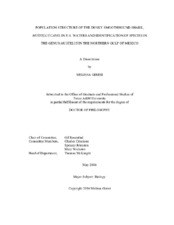Population Structure of the Dusky Smoothhound Shark, Mustelus Canis, in U.S. Waters and Identification of Species in the Genus Mustelus in the Northern Gulf of Mexico
Abstract
Globally, the genus Mustelus (smoothhound sharks) represents one of the most speciose groups of cartilaginous fishes. Morphological similarities and geographic overlap among species cause difficulties with species identification and taxonomy. Four morphologically conserved species (Mustelus canis canis, Mustelus sinusmexicanus, Mustelus norrisi and Mustelus higmani) are thought to occur within the northern Gulf of Mexico (Gulf). Available morphological keys are inadequate to distinguish among these species, and as such, all smoothounds in the U.S. Atlantic will be be managed as a species complex.
The primary objectives of this study were to (i) develop and utilize molecular methods to distinguish among smoothhound species in the Gulf; (ii) identify morphological characters that can be used in field surveys to distinguish among the smoothhound species in the Gulf; (iii) test the null hypothesis that Mustelus canis is comprised of a single genetically panmictic stock in waters of the U.S. Atlantic (including the Gulf); (iv) assess genetic connectivity of M. canis in U.S. waters, and (v) to estimate the effective size and effective number of breeders from each locality sampled.
Phylogenetic analysis of sequences of the mitochondrially-encoded NADH-2 gene resolved three reciprocally monophyletic lineages, which were identified as Mustelus canis, Mustelus norrisi, and Mustelus sinusmexicanus. Concordant with these results, comparisons of multi-locus, nuclear-encoded microsatellite genotypes also resolved three unambiguous groups. Using genetically verified voucher specimens, a field key outlining external characters was developed to aid field identification of the three species in the Gulf. Comparisons of environmental variables among specimens indicated that the three species, while co-distributed, might be partitioning the habitat based on depth and/or temperature tolerance.
Comparisons of ND-2 sequences and microsatellite genotypes among M. canis from localities throughout the U.S. Atlantic (including the northern Gulf of Mexico) rejected the null hypothesis that M. canis in U.S. waters of the western Atlantic comprises one genetically panmictic stock. Low but significant genetic structure was found between M. canis in the Gulf and the Atlantic, and also within ocean basins. The results of these studies have important implications for fisheries management of smoothhound sharks in the United States.
Citation
Giresi, Melissa (2016). Population Structure of the Dusky Smoothhound Shark, Mustelus Canis, in U.S. Waters and Identification of Species in the Genus Mustelus in the Northern Gulf of Mexico. Doctoral dissertation, Texas A&M University. Available electronically from https : / /hdl .handle .net /1969 .1 /187429.


